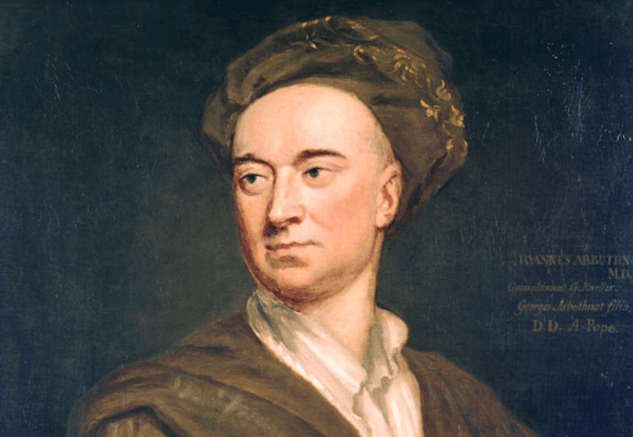Explore the life and achievements of John Arbuthnot, the Scottish physician, satirist, and mathematician. From medicine to literature, his diverse contributions shaped the intellectual landscape of the 18th century.

John Arbuthnot (1667–1735) was a Scottish physician, satirist, and polymath. He is best known for his contributions to literature, mathematics, and medicine. He established John Bull as the popular symbol of Britain, although he did not invent the character.
Arbuthnot was born at Arbuthnot, Kincardine County, Scotland, on April 29, 1667. He taught mathematics for a time in London before entering University College, Oxford, in 1692. In 1696 be received his M.D. degree from the University of St. Andrews in Scotland. He was elected fellow of the Royal Society in 1704 and a fellow of the Royal College of Physicians in 1710. He was physician to Queen Anne from 1705 until ker death in 1714. He held no public appointment under George I, but after the accession of George II in 1727 he was appointed physician to Queen Caroline. He died in London on Feb. 21,1735.
Arbuthnot published works on a great many subjects and even wrote a poem, Know Thyself (1734), but he is probably most famous for a series of five pamphlets issued in 1712 and collated under the title The History of John Bull. The pamphlets were in support of the efforts of the recently installed Tory ministry to bring to an end the long and costly War of the Spanish Succession. Originally titled Law Is a Bottomless fit, the pamphlets satirized the war under the guise of a suit brought by John Bull (England) and Nicholas Frog (Holland) against Lewis Baboon (Louis XIV of France) for the estate of the late Lord Strutt (Spain). John Bull was depicted as bluff and hearty, but gullible, cheated by his associates, and worn out by the stubborn tackiness of his adversary. John Bull as the typical Englishman immediately took a place in popular speech which he has never lost.
About 1713, Arbuthnot formed, with Jonathan Swift, Alexander Pope, John Gay, and Thomas Parnell, the nonpolitical Scriblerus Club. The toiect of the club, said Pope, was “to have ridiculed all the false tastes in learning, under the character of a man of capacity enough, that had dipped into every art and science, but injudiciously in each.” The resulting satiric essays were published by Pope in 1741 as Memoirs of the Extraordinary Life, Works, and Discoveries of Martinus Scriblerus; almost the whole work, except for Pope’s own famous essay on The Art of Sinking in Poetry, was of Arbuthnot’s writing.
Genial, erudite, and witty, Arbuthnot, as Lord Chesterfield said, placed his fund of wit at the disposal of his friends, without any thought of his own reputation. He had, indeed, a genius for friendship which endeared him alike to the arrogant Swift and the waspish Pope. The latter addressed to Arbuthnot the wittiest of all his poetic epistles; Swift, in his satiric lines on his own death, named Arbuthnot, after Pope and Gay, as the third and last of the friends who would sincerely grieve.
Contributions
He is best known for his contributions to literature, mathematics, and medicine. Here are some key aspects of his life and work:
- Medical Career: Arbuthnot studied medicine at the University of St Andrews and practiced as a physician. He became a fellow of the Royal College of Physicians in 1696.
- Literary Contributions: Arbuthnot was a member of the “Scriblerus Club,” a group of writers that included Jonathan Swift and Alexander Pope. Together, they collaborated on various satirical works. Arbuthnot himself wrote satirical essays and pamphlets, often using humor to comment on political and social issues of his time.
- Mathematical Contributions: Arbuthnot also made contributions to mathematics, particularly in the field of probability. He is credited with the development of the concept of the “law of averages” and the study of mortality statistics. He used statistical methods to analyze the population and mortality data in a famous work titled “An Argument for Divine Providence, Taken from the Constant Regularity Observ’d in the Births of Both Sexes” (1710).
- Political Engagement: Arbuthnot was involved in political circles and was a supporter of the Tory party. He wrote satirical works that reflected his political views, and his writings often targeted figures in the Whig government.
- Friendship with Jonathan Swift: Arbuthnot and Jonathan Swift were close friends, and Arbuthnot played a significant role in the literary and satirical activities of the time. He is mentioned in Swift’s famous work “Gulliver’s Travels” as the author of Gulliver’s voyage to the land of Lilliput.
- Legacy: Arbuthnot’s contributions to literature, medicine, and mathematics were diverse, and he left a lasting impact on these fields. His wit and satire continue to be studied, and his work in statistics laid the groundwork for later developments in the field.
John Arbuthnot’s multidisciplinary contributions make him a notable figure of the early 18th century, and his works remain of interest to scholars and researchers in various fields.